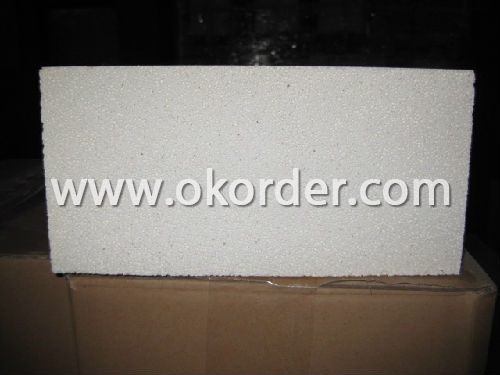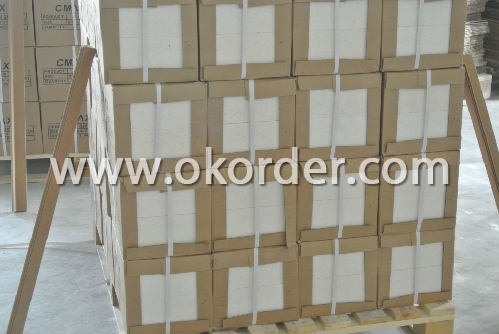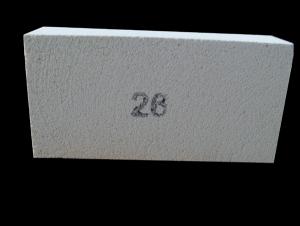Insulating Fire Brick-MS23
- Loading Port:
- China Main Port
- Payment Terms:
- TT or L/C
- Min Order Qty:
- 1000 pcs pc
- Supply Capability:
- 1000 Tons Per Month pc/month
OKorder Service Pledge
OKorder Financial Service
You Might Also Like
General Information of insulating fire bricks MS23
The insulating firebricks temperature is 1260℃(2300℉) and the bricks are manufactured from high purity alumina clay.
Feature of insulating fire bricks MS23
Light weight and low thermal conductivity
Low heat storage
Low iron and impurities
High thermal shock resistance
Application of insulating fire bricks MS23
The insulating firebricks can be used as a hot face lining directly exposed to the heat or as a backup insulation layer in iron and steel mills, non-ferrous foundries, petrochemical, ceramic, glass.
Technical Data of insulating fire bricks MS23
|
| MS23 |
Physical Properties: |
|
|
Classifiction Temperature | ℃ | 1260.0 |
Density | Kg/m3 | 550.0 |
Cold Crushing Strength | Mpa | 1.2 |
Reheating Linear Change(24hrs) |
|
|
1230℃ | % | 0.4 |
Hot Load Strength Deform(90 minutes) |
|
|
1100℃ at 0.034 Mpa(5psi) | % | 0.1 |
Thermal Conductivity |
|
|
400℃ | W/m.k | 0.2 |
600℃ | W/m.k | 0.2 |
800℃ | W/m.k | 0.2 |
1000℃ | W/m.k | 0.2 |
Specific Heat | KJ/Kg.K | 1.1 |
Chemical Analysis: |
|
|
Al2O3 | % | 47.0 |
SiO2 | % | 44.4 |
Fe2O3 | % | 0.9 |
TiO2 | % | 1.2 |
CaO | % | 5.2 |
MgO | % | 0.3 |
Na2O+K2O | % | 1.1 |


- Q:How do insulating fire bricks help reduce heat loss through conduction?
- Insulating fire bricks are specifically designed to minimize the loss of heat through conduction by utilizing their unique properties. These bricks are manufactured using a special lightweight refractory material, such as ceramic fibers or a combination of high-alumina and silica, which possess a low thermal conductivity. The low thermal conductivity of insulating fire bricks serves to diminish the transfer of heat through conduction. When heat is applied to one side of the brick, the material's low thermal conductivity prevents the rapid flow of heat to the other side. Consequently, less heat is lost through the brick via conduction, leading to enhanced insulation and energy efficiency. Moreover, insulating fire bricks often exhibit a high level of porosity, which results in the formation of air pockets within the material. These air pockets function as barriers to heat transfer since air is a poor conductor of heat. By ensnaring air within the structure of the brick, insulating fire bricks effectively decelerate the movement of heat, further reducing heat loss through conduction. Additionally, insulating fire bricks possess a high melting point, enabling them to endure extreme temperatures without distorting or deteriorating. This characteristic guarantees that the bricks can proficiently insulate against heat transfer even in high-temperature environments, such as furnaces or kilns. In conclusion, insulating fire bricks aid in diminishing heat loss through conduction by virtue of their low thermal conductivity, high porosity, and high melting point. These bricks capably restrict the transmission of heat from one side to the other, thereby minimizing energy loss and enhancing insulation efficiency.
- Q:Are insulating fire bricks resistant to acid attack?
- Yes, insulating fire bricks are resistant to acid attack.
- Q:Can insulating fire bricks be used in the construction of glass bottle production furnaces?
- Yes, insulating fire bricks can be used in the construction of glass bottle production furnaces. Insulating fire bricks are designed to withstand high temperatures and provide excellent thermal insulation. They are often used in applications that require heat retention and energy efficiency, such as furnaces. By using insulating fire bricks in the construction of glass bottle production furnaces, the heat generated during the glass-making process can be effectively contained within the furnace, reducing heat loss and improving energy efficiency. This can result in cost savings and improved production performance. Additionally, insulating fire bricks can help protect the structural integrity of the furnace by minimizing thermal stress and preventing heat transfer to the surrounding environment. Overall, the use of insulating fire bricks in glass bottle production furnaces can contribute to more efficient and durable furnace operation.
- Q:Are insulating fire bricks resistant to weathering or aging?
- Insulating fire bricks exhibit exceptional resistance to weathering and aging. These bricks are specifically engineered to endure extreme temperatures and harsh environmental conditions. They are composed of top-notch refractory materials, including alumina, silica, and other additives, which confer exceptional thermal insulation properties and strong resistance to corrosion and erosion. The manufacturing process of insulating fire bricks entails meticulous selection of raw materials and precise control of firing temperatures, resulting in a dense and homogeneous structure. This structure effectively prevents moisture and other weathering agents from infiltrating, thus ensuring extended durability and resistance to aging. Moreover, insulating fire bricks are also highly resistant to thermal shock, enabling them to withstand rapid temperature fluctuations without fracturing or disintegrating. This characteristic bolsters their ability to withstand adverse weather conditions. All in all, insulating fire bricks have demonstrated remarkable dependability in diverse applications that involve exposure to weathering elements. They find widespread usage in industries such as steel, ceramic, glass, and cement manufacturing, as well as in high-temperature applications like kilns, furnaces, and chimneys.
- Q:Are insulating fire bricks safe to use?
- Insulating fire bricks are generally safe to use when used properly and in accordance with the manufacturer's instructions. These bricks are designed to withstand high temperatures and provide excellent insulation, making them ideal for applications such as lining kilns, furnaces, and fireplaces. Insulating fire bricks are made from lightweight materials such as alumina, silica, and other refractory materials. They are designed to minimize heat transfer, thus preventing the escape of heat from the enclosed area. This not only improves the energy efficiency of the system but also enhances safety by reducing the risk of overheating and potential fires. When using insulating fire bricks, it is essential to ensure that they are installed correctly and securely. Proper installation includes providing adequate support and reinforcement to prevent collapse or shifting of the bricks. Additionally, it is crucial to use appropriate mortar or refractory cement to join the bricks together, ensuring a strong and stable structure. While insulating fire bricks themselves are considered safe, it is important to note that they may contain small amounts of trace elements or materials that can be harmful if released into the environment. Therefore, it is recommended to follow the manufacturer's safety guidelines, such as wearing gloves, goggles, and a dust mask when handling the bricks. Overall, insulating fire bricks are a safe and reliable choice for insulation in high-temperature applications. However, it is important to take necessary precautions during installation and follow safety guidelines to ensure their proper and safe use.
- Q:Are insulating fire bricks resistant to oil or chemical spills?
- Insulating fire bricks lack resistance to oil or chemical spills in general. Their main purpose is to endure high temperatures and offer insulation in various settings, such as furnaces, kilns, and fireplaces. Despite their efficient handling of heat and thermal shock, these bricks are typically composed of materials like clay, alumina, or silica, which do not possess inherent resistance to oil or chemicals. In the event of exposure to oil or chemical spills, these bricks may absorb the substances, potentially resulting in degradation or diminished performance over time. Hence, if oil or chemical resistance is a crucial requirement, it is advisable to explore alternative materials explicitly designed for such applications.
- Q:Are insulating fire bricks resistant to sound transmission?
- Insulating fire bricks, which are also known as refractory bricks, are primarily designed to withstand high temperatures and provide thermal insulation. Despite their effectiveness in reducing heat transfer, they are not specifically engineered to resist sound transmission. The composition of insulating fire bricks consists of materials like clay, alumina, and silica, carefully selected for their ability to withstand high temperatures. These materials possess density and low porosity, which aids in blocking the passage of heat through the bricks. However, solid materials, including insulating fire bricks, allow sound waves to easily pass through unless additional measures are taken to mitigate sound transmission. To effectively minimize sound transmission, it is advisable to employ other soundproofing techniques in conjunction with insulating fire bricks. These methods may involve incorporating additional layers of acoustic insulation or utilizing sound barriers like mass-loaded vinyl or acoustic panels. In summary, while insulating fire bricks excel in providing thermal insulation, they do not possess inherent resistance to sound transmission. To efficaciously minimize noise transmission within a given area, supplementary soundproofing measures should be implemented.
- Q:Do insulating fire bricks require a refractory mortar for installation?
- For proper installation, insulating fire bricks typically require the use of refractory mortar. These bricks are lightweight and have excellent insulating properties, making them well-suited for applications that prioritize thermal efficiency. However, their lightweight nature also means they are more fragile and susceptible to cracking or breaking when subjected to stress. To establish a robust and durable bond between the bricks, it is essential to use a refractory mortar specifically designed for high-temperature applications. These mortars are formulated to withstand high temperatures and possess superior adhesion and thermal expansion properties. By filling in the gaps between the bricks and providing additional support, this mortar helps create a solid and secure structure. Failure to use refractory mortar can lead to inadequate securing of the insulating fire bricks, potentially causing them to shift or separate over time and compromising the integrity of the installation. Additionally, the absence of refractory mortar may result in reduced thermal efficiency due to increased heat loss through gaps and spaces between the bricks. Therefore, it is highly advisable to employ refractory mortar when installing insulating fire bricks to ensure the construction remains strong and long-lasting.
- Q:Can insulating fire bricks be used for insulation in foundries?
- Insulating fire bricks have the capability to be utilized for insulation purposes in foundries. These bricks are specially constructed to possess a high level of thermal resistance and a low level of thermal conductivity, rendering them exceptionally suitable for scenarios that necessitate insulation. In the context of foundries, where elevated temperatures are present, insulating fire bricks can be employed to line the walls, floors, and roofs, thus diminishing heat loss and enhancing energy efficiency. Furthermore, they contribute to maintaining a consistent temperature within the foundry, thereby ensuring uniform dispersion of heat while preventing heat loss to the surrounding environment. Moreover, owing to their lightweight nature and easy installation process, insulating fire bricks emerge as a pragmatic choice for insulation in foundries.
- Q:Can insulating fire bricks be used in biomass boilers?
- Yes, insulating fire bricks can be used in biomass boilers. These bricks are designed to withstand high temperatures and provide excellent insulation, making them suitable for use in biomass boilers where heat retention is crucial for efficient combustion.
1. Manufacturer Overview |
|
|---|---|
| Location | Jiangsu, China |
| Year Established | 2008 |
| Annual Output Value | Above US$ 35 Million |
| Main Markets | Germany; Italy; Turkey; France; England; Japan; Thailand; Vietnam; Idonesia; USA |
| Company Certifications | ISO 9001:2008 |
2. Manufacturer Certificates |
|
|---|---|
| a) Certification Name | |
| Range | |
| Reference | |
| Validity Period | |
3. Manufacturer Capability |
|
|---|---|
| a)Trade Capacity | |
| Nearest Port | Shanghai; Qingdao |
| Export Percentage | 10% |
| No.of Employees in Trade Department | 3 People |
| Language Spoken: | English; Chinese; |
| b)Factory Information | |
| Factory Size: | Twenty five thousand tons per year |
| No. of Production Lines | Above 5 |
| Contract Manufacturing | OEM Service Offered; Design Service Offered |
| Product Price Range | High; Average |
Send your message to us
Insulating Fire Brick-MS23
- Loading Port:
- China Main Port
- Payment Terms:
- TT or L/C
- Min Order Qty:
- 1000 pcs pc
- Supply Capability:
- 1000 Tons Per Month pc/month
OKorder Service Pledge
OKorder Financial Service
Similar products
New products
Hot products
Related keywords



























